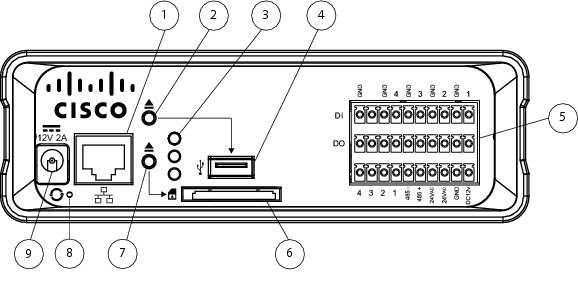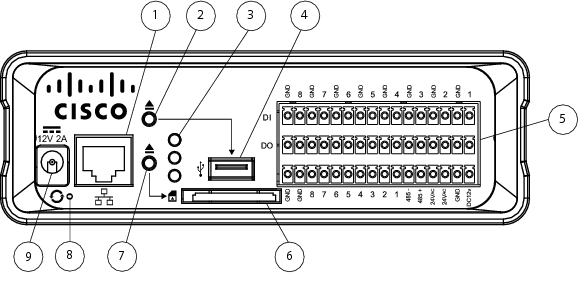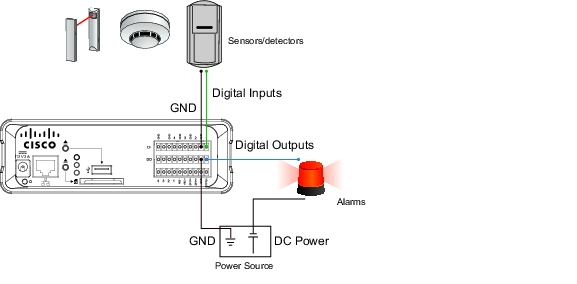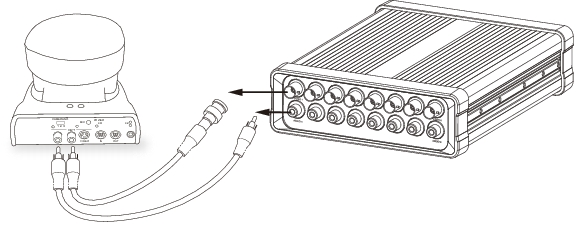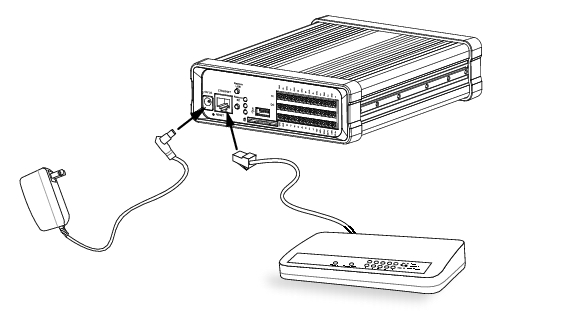

Table Of Contents
CIVS-SENC-4P Front and Back View
CIVS-SENC-8P Front and Back View
Pin Definitions of the General I/O Terminal Blocks
Setting up the Encoder on the Network
Setting up the Encoder Behind a Router
Setting up the Encoder Using a Static IP Address
Overview
The Cisco video surveillance encoders, models CIVS-SENC-4P and CIVS-SENC-8P, convert analog video into high quality digital video, and set a new standard in encoder security. The CIVS-SENC-4P and CIVS-SENC-8P models contain the following key features:
•
Allow 4-CH or 8-CH high resolution video capture with a high frame rate.
•
Use the H.264 compression format, resulting in greatly reduced video file sizes, and conserving valuable bandwidth and storage space.
•
The 4 port model, CIVS-SENC-4P, supports simultaneous dual streams, while the 8 port model, CIVS-SENC-8P, supports single stream to be transmitted in H.264, MPEG-4, and MJPEG formats. The video stream can also be individually configured with frame rates, resolution, and image quality to meet different platforms or bandwidth constraints.
•
Use motion detection.
•
Upgrade the security level of the associated IP surveillance system with the HTTPS network security protocol.
•
Compatible with Cisco Video Surveillance Manager Version 6.3.2 and later software, providing scalability and easy-to-use operation.
•
Designed as a rack mount solution for easy installation. (Needs optional accessory kit.)
These features make the CIVS-SENC-4P and CIVS-SENC-8P models easy to install and integrate with an existing analog camera. As a highly innovative video encoder series, the CIVS-SENC-4P and CIVS-SENC-8P models allow you to easily upgrade to a full-featured, high-end, IP surveillance solution.
Read Before Use
It is important to verify that all contents received are complete according to the package contents list (see the "Package Contents" section). Take note of the warnings in the Quick Start Guide before installing the encoder; then carefully read and follow the instructions in the Network Deployment section of this guide (see the "Network Deployment" section) to avoid damage during installation.
The encoder is a network device, and it is designed for various applications, including video sharing, general security/surveillance, and so on. The Configuration chapter (see the "Configuration" section) suggests ways to make best use of the encoder, and to ensure proper operation.
Package Contents
The Cisco video surveillance encoder package includes these items:
•
CIVS-SENC-4P (4 channel) or CIVS-SENC-8P (8 channel) encoder (qty. 1)
•
Power adapter (qty. 1)
•
General I/O terminal blocks for CIVS-SENC-4P (10 pins x 3 pieces) or CIVS-SENC-8P (16 pins x 3 pieces) (qty. 3)
•
Warranty card (qty. 1)
Physical Description
CIVS-SENC-4P Front and Back View
Figure 1-1 shows the front view of the CIVS-SENC-4P encoder. The top row is comprised of four video input slots, and the bottom row is comprised of four audio input slots.
Figure 1-1 CIVS-SENC-4P Front View
Figure 1-2 shows the back view of the CIVS-SENC-4P encoder.
Figure 1-2 CIVS-SENC-4P Back View
Ethernet 10/100/1000 RJ45 port
SD/SDHC card slot. While the SD/SDHC slot is on the device, it is not currently supported by Cisco.
In encoders that support USB, press this button before removing the USB device.
In encoders that support SD/SDHC, press this button before removing the SD/SDHC device.
Status LEDs. For more information, see the "Status LED" section.
Reset button (recessed). For more information, see the "Hardware Reset" section.
USB port. While the USB port is on the device, it is not currently supported by Cisco.
Power input
General I/O terminal block. For more information, see the "General I/O Terminal Block" section.
Note
Where enabled, the USB port is for maintenance purposes only.
CIVS-SENC-8P Front and Back View
Figure 1-3 shows the front view of the CIVS-SENC-8P encoder. The top row is comprised of eight video input slots, and the bottom row is comprised of eight audio input slots.
Figure 1-3 CIVS-SENC-8P Front View
Figure 1-4 shows the back view of the CIVS-SENC-8P encoder.
Figure 1-4 CIVS-SENC-8P Back View
Ethernet 10/100/1000 RJ45 port
SD/SDHC card slot. While the SD/SDHC slot is on the device, it is not currently supported by Cisco.
In encoders that support USB, press this button before removing the USB device.
In encoders that support SD/SDHC, press this button before removing the SD/SDHC device.
Status LEDs. For more information, see the "Status LED" section.
Reset button (recessed). For more information, see "Hardware Reset" section.
USB port. While the USB port is on the device, it is not currently supported by Cisco.
Power input
General I/O terminal block. For more information, see "General I/O Terminal Block" section.
Note
Where enabled, the USB port is for maintenance purposes only.
General I/O Terminal Block
This encoder provides a general I/O terminal block which is used to connect external input /output devices. For information about the pin definitions, see the "Pin Definitions of the General I/O Terminal Blocks" section.
Pin Definitions of the General I/O Terminal Blocks
Figure 1-5 shows the pin locations on the back panel of the CIVS-SENC-4P encoder, and Table 1-1 provides definitions for each of the pins.l
Figure 1-5 CIVS-SENC-4P Pin Locations
Figure 1-6 shows the pin locations on the back panel of the CIVS-SENC-8P encoder, and Table 1-2 provides definitions for each of the pins.
Figure 1-6 CIVS-SENC-8P Pin Locations
DI/DO Diagram
Figure 1-7 shows the connections necessary to set up the encoder with various external devices.
Figure 1-7 DI/DO Connections
Note
The following guidelines should be observed:
•
External alarms or other devices that connect to the digital outputs require an external power supply, for example, DC power from a power adapter.
•
12V Ground should connect to the encoder ground terminal block. For detailed pin definitions, see the "Pin Definitions of the General I/O Terminal Blocks" section.
•
It is recommended that you keep the current running through each of the DO lines under 1A.
Status LED
The LED indicates the status of the encoder. Table 1-3 describes the different status levels of the Yellow (SD), Green (Network), and Red (Power) LEDs.
Table 1-4 describes LED blinking states.
Hardware Reset
See Figure 1-2 (CIVS-SENC-4P) or Figure 1-4 (CIVS-SENC-8P) for the location of the hardware reset button on your encoder. The reset button is used to reset the system or to restore the factory default settings. Sometimes, if your encoder is experiencing a problem, resetting the system can return the encoder to normal operation. If, after performing a reset, the problem remains, restore the factory settings and install the system again.
Use one of the following methods to reset or restore the settings:
•
Reset—Press and release the recessed reset button using a straightened paper clip. Wait for the encoder to reboot.
•
Restore—Press and hold the reset button down until the status LED blinks rapidly. It takes about 30 seconds. Note that all settings are restored to factory default. When the system has been restored successfully, the status LED blinks green and red during normal operation.
Network Deployment
Setting up the Encoder on the Network
To connect the encoder to the camera and the network, follow these steps:
Procedure
Step 1
Connect the video out slot on the camera to a BNC video input slot on the encoder. See Figure 1-8.
Step 2
Connect the line-out audio source on the camera to an RCA audio input slot on the encoder.
Figure 1-8 Video and Audio Connections
Step 3
Connect the encoder to a switch using an Ethernet cable. See Figure 1-9.
Step 4
Connect the encoder to a power outlet using the power cable.
Step 5
If you have external devices, such as sensors or alarms, connect them to the general I/O terminal block. For detailed pin definitions, see the "Pin Definitions of the General I/O Terminal Blocks" section.
Figure 1-9 Network, Power, and External Device Connections
Step 6
You can set up the encoder on the network in any of the following ways:
•
Set up the encoder behind a router. For more information, see the "Setting up the Encoder Behind a Router" section.
•
Use a static IP address. For more information, see the "Setting up the Encoder Using a Static IP Address" section.
•
Use PPPoE. For more information, see the "Ready to Use" section.
Setting up the Encoder Behind a Router
To set up the encoder behind a router, perform the following procedure:
Before you begin
•
Make sure you have a router.
•
Find out the public IP address of your router provided by your ISP (Internet Service Provider).
Procedure
Step 1
Connect your encoder behind a router. For information on how to obtain your IP address, see the "Accessing the Encoder" section.
Step 2
In this case, if the Local Area Network (LAN) IP address of your encoder is 192.168.0.3, forward the following ports for the encoder on the router:
•
HTTP port
•
RTSP port
•
RTP port for audio
•
RTCP port for audio
•
RTP port for video
•
RTCP port for video
If you have changed the port numbers on the Network window, open the ports accordingly on your router. For information on how to forward ports on the router, refer to the user manual for your router.
Step 3
Use the public IP address of your router and the secondary HTTP port to access the encoder from the Internet. For more information, see the "Network Type Settings" section.
Setting up the Encoder Using a Static IP Address
Choose this connection type if you are required to use a static IP address for the encoder. For more information, see the "LAN Settings" section.
Enabling Authentication
Cisco recommends that you use the following procedure to enable authentication on the encoder via its Web-based user interface.
Procedure
Step 1
On the home window of the encoder user interface, choose Configuration > Security.
For more information about accessing the encoder user interface, see the "Accessing the Encoder" section.
Step 2
Set a root password and then confirm it.
Note
These encoders allow up to 20 user accounts plus the root account. The default passwords are blank for both users and the root. For user names and all passwords, the minimum length is one character and the maximum length allowed is 64 characters. The root, user names, and their passwords can include the following characters: a-z, A-Z, 0-9, !, $, %, -, . , ^, _, ~, @
Step 3
In the Manage Privilege area, ensure that the Allow Anonymous Viewing checkbox is unchecked.
Step 4
Click Save.
Step 5
Click HTTPS in the left-hand pane, ensure that the Enable HTTPS secure connection checkbox is unchecked, and click Save.
HTTPS is not supported by VSM.
Step 6
Click Network in the left-hand pane and do the following:
•
In the HTTP area, choose Basic on the Authentication drop-down menu, and ensure that the HTTP port is 80.
•
In the RTSP Streaming area, choose Basic on the Authentication drop-down menu. The digest mode is not supported.
•
Click Save.
Note
The credentials you set up here should also be used when the encoder is added in Video Surveillance Manager Server (VSMS) and Video Surveillance Operations Manager (VSOM).
Ready to Use
When you have completed setup, you are ready to access the encoder. For more information, see the "Accessing the Encoder" section.

 Feedback
Feedback
